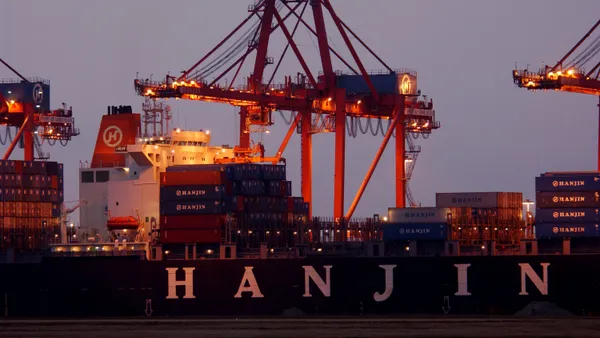Dive Brief:
- The top four West Coast ports reached a new threshold in July, as they handled a combined 1 million TEUs of loaded container imports for the first time in at least two years, according to data collected by Supply Chain Dive.
- July, however, was far from the best import month this year for all ports. Loaded container imports at the Port of Long Beach and Port of Oakland dipped compared to last year — by 8.2% and 0.6%, respectively.
- The decline was largely offset by gains at the Port of Los Angeles and the Northwest Seaport Alliance, where loaded import containers rose 5.1% and 19.8%, respectively.
Dive Insight:
July 2018 was not the best month in history for any of the ports, but altogether, the West Coast gateways are reaching new thresholds of total imports handled.
The biggest story lies at the nation's largest maritime complex, where the Port of Los Angeles saw volumes rise 55,200 TEUs from June's figures, whereas the Port of Long Beach saw its imports fall 36,359 TEUs month-to-month. July's figures, however, remained largely on par with Long Beach's import volumes in August, suggesting a more permanent shift in cargo flow.
"Our Port’s decline in cargo over the last two months is in large part due to a realignment of ocean carrier alliance services and port calls," said Port of Long Beach Executive Director Mario Cordero in a statement this week. "Another factor is higher tariffs by the United States and China. Thus far, that appears to have helped increase traffic, as shippers act to beat duties imposed on goods this summer."
The question now is whether July marked a new record for peak season due to a rush to beat tariffs, as Cordero alludes to, or if it is just a side effect of general economic gains.
July 2017 was also the month with the highest combined loaded container imports (990,000 TEUs) among the four top West Coast ports in that year. August 2017, by contrast, only saw a combined 986,000 TEUs of loaded containers imported at the four ports.
During the previous year, however, imports peaked in August. In August 2016, the four ports handled 930,000 TEUs, versus the 887,000 TEus handled in July 2016.
Based on the past two years of data, supply chains have tended toward importing more in July and August than most other months of the year. A record-setting July is not unusual. A record-high August would also be normal and expected, even if the tariff-rush is widespread (tariffs began to be collected Aug. 23).
But as far as our data shows, 1-million TEUs handled in an otherwise normal month for individual ports is a record, and when compared to 2016, it signals peak shipping season continues to get earlier.














